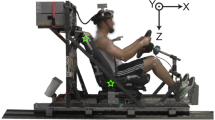Abstract
Frontal impacts are a common cause of whiplash injury. Yet, volunteer studies of the cervical muscular response and head–neck kinematics to frontal impacts are uncommon, and specifically, the effect of an offset (anterolateral) frontal impact on the resultant muscle responses is unknown. The purpose of this study was to determine the response of the cervical muscles to increasing low-velocity frontal impacts offset by 45° to the right, and to compare the quantitative effects of expected and unexpected impact. Ten healthy volunteers were subjected to frontal impacts, offset by 45° to the subject’s right, of 5.1-, 8.7-, 12-, and 13.7-m/s2 peak acceleration at two levels of expectation: expected and unexpected. Bilateral electromyograms of the sternocleidomastoids, trapezii, and splenii capitis were recorded. Triaxial accelerometers recorded the acceleration of the chair, torso at the shoulder level, and head of the participant. At a peak acceleration of 13.7 m/s2, with an unexpected impact, the contralateral trapezius (i.e., left trapezius in a right anterolateral impact) generated 83% of its maximal voluntary contraction electromyogram, whereas all other muscles generated 50% or less of this variable. Although it generated less EMG, the splenius capitis muscle also tended to show an asymmetric EMG response, with the left (contralateral) splenius capitis generating a higher percentage (46%) of its maximal voluntary contraction electromyogram than the ipsilateral (right) splenius capitis. In comparison, the sternocleidomastoid muscles behaved symmetrically and generated 25% or less of this variable under all impact conditions. Similarly, the times to onset and times to peak electromyogram for the contralateral (left) splenius capitis and (left) trapezius progressively decreased with increasing levels of acceleration (p<0.01). Subjects exhibited lower levels of their maximal voluntary contraction electromyogram when the impact was expected (p<0.01). The kinetic variables and the electromyographic variables regressed significantly on the acceleration (p<0.01). In response to right anterolateral impacts, muscle responses were greater with higher levels of acceleration, and more specifically, when a frontal impact is offset to the subject’s right, it results in not only increased EMG generation in the contralateral trapezius, but the splenius capitis contralateral to the direction of impact also bears part of the force of the neck pertubation. Expecting or being aware of imminent impact plays a role in reducing muscle responses in low-velocity anterolateral impacts.





Similar content being viewed by others
References
Brault JR, Wheeler JB, Siegmund GP, Brault EJ (1998) Clinical response of human subjects to rear-end automobile collisions. Arch Phys Med Rehabil 79:72–80
Cassidy JD, Carroll LJ, Cote P, Lemstra M, Berglund A, Nygren A (2000) Effect of eliminating compensation for pain and suffering on the outcome of insurance claims for whiplash injury. N Engl J Med 342:1179–1186
Castro WH, Schilgen M, Meyer S, Weber M, Peuker C, Wortler K (1997) Do “whiplash injuries” occur in low-speed rear impacts? Eur Spine J 6:366–375
Ferrari R (1999) The whiplash encyclopedia. The facts and myths of whiplash. Aspen, Gaithersburg, Maryland, pp 449–470
Kumar S, Narayan Y, Amell T (2000) Role of awareness in head–neck acceleration in low velocity rear-end impacts. Accid Anal Prev 32:233–241
Kumar S, Narayan Y, Amell T (2001) Cervical strength of young adults in sagittal, coronal, and intermediate planes. Clin Biomech 6:380–388
Kumar S, Narayan Y, Amell T (2002) An electromyographic study of low-velocity rear-end impacts. Spine 27:1044–1055
Kumar S, Narayan Y, Amell T, Ferrari R (2002) Electromyography of superficial cervical muscles with exertions in sagittal, coronal, and oblique planes. Eur Spine J 11:27–1137
Kumar S, Narayan Y, Amell T (in press) Analysis of low-velocity frontal impacts. Clin Biomech
Magnusson ML, Pope MH, Hasselquist L, Bolte KM, Ross M, Goel VK (1998) Cervical electromyographic activity during low-speed rear-end impact. Eur Spine J 8:118–125
Nederhand MJ, Ijzerman MJ, Hermens HJ, Baten CT, Zilvold G (2000) Cervical muscle dysfunction in the chronic whiplash associated disorder grade II (WAD-II). Spine 25:1938–1943
Nederhand MJ, Hermens HJ, Ijzerman MJ, Turk DC, Zilvold G (2002) Cervical muscle dysfunction in the chronic whiplash associated disorder grade II: the relevance of the trauma. Spine 27:1056–1061
Nederhand MJ, Hermens HJ, Ijzerman MJ, Turk DC, Zilvold G (2003) Chronic neck pain disability due to an acute whiplash injury. Pain 102:63–71
Siegmund GP, Sanderson DJ, Myers BS, Inglis JT (2003) Awareness affects the response of human subjects exposed to a single whiplash-like perturbation. Spine 28:671–679
Spitzer WO, Skovron ML, Salmi LR, Cassidy JD, Duranceau J, Suissa S et al. (1995) Scientific monograph of the Quebec Task Force on Whiplash-Associated Disorders. Spine 120 (Suppl 8):1S–73S
Szabo TJ, Welcher J (1992) Dynamics of low speed crash tests with energy absorbing bumpers. Soc Automotive Eng 101:1367–1375
Szabo TJ, Welcher J, Anderson RD (1994) Human occupant kinematic response to low speed rear-end impacts. Proc of the 38th Stapp Car Crash Conference. Society of Automotive Engineers, Warrendale, Pennsylvania, pp 23–35
Author information
Authors and Affiliations
Corresponding author
Rights and permissions
About this article
Cite this article
Kumar, S., Ferrari, R. & Narayan, Y. Cervical muscle response to whiplash-type right anterolateral impacts. Eur Spine J 13, 398–407 (2004). https://doi.org/10.1007/s00586-004-0700-x
Received:
Revised:
Accepted:
Published:
Issue Date:
DOI: https://doi.org/10.1007/s00586-004-0700-x




